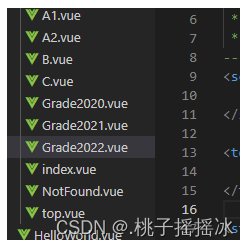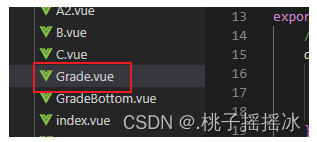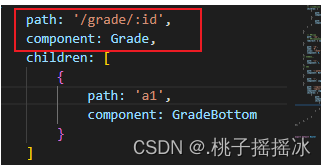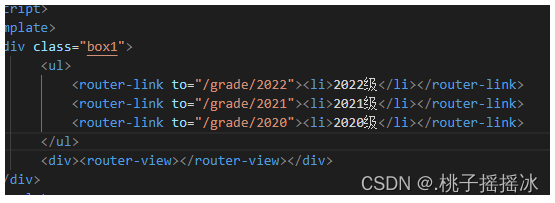Vue-router
路由的核心:改变URL,页面不会整体刷新
一、创建项目
1、使用vite创建项目
npm init vue@latest
注意:根据需求,选择‘可选功能’完成安装(具体安装步骤vue.md)
2、项目结构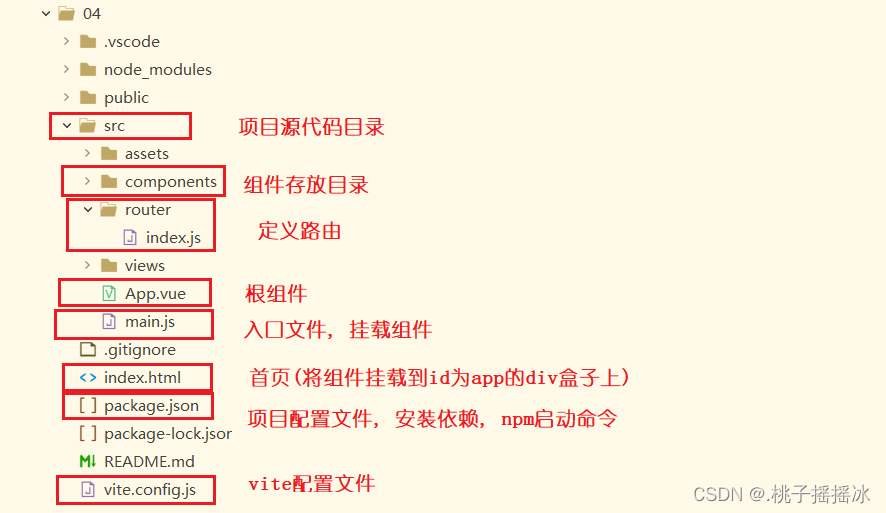
3、创建登录项目
<1>创建一个组件(登录页面),我们把这个组件称为单文件组件
位置:(规范情况下,将组件写到components目录下)
命名:大驼峰式命名规则
格式(三个部分):
<script></script><template></template><style scoped></style>
<2>Login.vue(登录组件)
<script>
export default {
// 响应式数据 data() 函数
data(){
return{
name:'',
password:'',
tip:'',
// 设置标识
flag:'false'
}
},
// 方法书写在 methods 中
methods:{
sign(){
// 先判断用户名和密码是否为空
if(this.name === '' || this.password === ''){
// 如果为空的弹出提示
this.flag='false'
this.tip='用户名和密码为空'
} else if(this.name ==='admin' && this.password === '123456'){
this.flag='true',
this.tip=''
// 跳转页面
this.$router.push({
path:'/logins'
})
} else {
this.flag='false',
this.tip='账号名或密码错误'
}
}
}
}
</script>
<template>
<div class="box1">
<div>
<h1>Login</h1>
<ul>
<label>
<li>用户:<input type="text" placeholder="请输入用户名" v-model.trim="name"></li>
</label>
<label>
<li>密码:<input type="password" placeholder="请输入密码" v-model.trim="password"></li>
</label>
<li><button @click="sign">登录</button></li>
<li v-show="flag" :class="{style1:flag}">
{{ this.tip }}
</li>
</ul>
</div>
</div>
</template>
// scoped 样式的作用域在本组件中
<style scoped>
div.box1 {
height: 50%;
width: 100%;
/* background-color: red; */
}
.style1{
color:red;
}
div.box1 div{
text-align: center;
height: 50%;
color:rgb(96, 207, 170);
/* background-color: aqua; */
border: 1px solid #111;
}
/* 注意:使用弹性布局时,内部所有的元素都会变成内联块 */
div.box1 div ul li {
margin-top: 10px;
list-style: none;
color:rgb(96, 207, 170)
}
div.box1 div ul li button {
width: 35%;
}
</style>
Tips:
1、使用弹性布局时,内部所有的元素都会变成内联块
2、在输入用户名和密码的时候,在表单元素上进行数据的双向绑定,v-model=‘响应式变量’,进行去除前后空格的修饰操作.trim
3、在按钮上取消默认行为(.prevent,相当于事件对象event.defaultPrevent()),并绑定点击事件,触发sign函数
相当于v-on=‘sign’ 简写为@click=‘sign’
4、响应式数据 模块是 data函数,返回一个对象
5、methods是一个对象,在对象内部书写各种函数
①书写函数sign函数
sign(){// 先判断用户名和密码是否为空if(this.name ===''||this.password ===''){// 如果为空的弹出提示this.flag='false'this.tip='用户名和密码为空'}elseif(this.name ==='admin'&&this.password ==='123456'){this.flag='true',this.tip=''// 跳转页面this.$router.push({path:'/logins'})}else{this.flag='false',this.tip='账号名或密码错误'}}
注意:
1、函数中获取响应式数据需要使用this获取
2、通过一个标识来判断提示信息是否弹出,使用v-show判断(注意:v-if和v-show的区别)
-------v-if(判断时,不断的销毁重建)
-------v-show(相当于使用display:none)
3、用户名和密码正确,进行跳转页面
②页面的跳转
使用路由router进行页面的跳转:用法:this.$router (路由实例)
this.$router.push()或replace()方法
启动项目,打开页面,直接进入login页面
方式一:将Login组件作为App.vue的子组件
在APP.vue中引入Login组件,并注册
<script>import Login from'./components/Login.vue'exportdefault{// 参数是对象components:{Login},}</script><template>// 组件一般都是大驼峰式,和html标签区分<Login></Login></template>
在使用时,将原有的所有样式都清除(src->assets->main.css)
启动项目,打开前端页面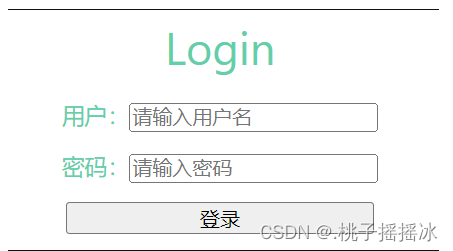
问题:在地址栏中输入任何内容,都会跳转到登录页面
原因:因为我们把Login组件作为了App.vue中模板的内容,App.vue是根组件,所以当我们的路径发生变化时,只会显示Login组件。我们所使用的this.$router.push就会失效,导致跳转不成功。
补充知识点:路由(router)
路由:是组件和路径的一一映射关系
位置:我们将路由再写(src->router->路由名称)
①创建路由
创建路由对象,通过createRouter函数创建,首先引入方法
import{ createRouter, createWebHashHistory }from"vue-router";通过createRouter函数创建路由
// 创建路由实例const Router =createRouter({// 模式有两种:createWebHashHistory()--路径中含有#,createWebHistory()history:createWebHashHistory(),// 将每个路由映射到对应的组件routes:[{path:'/logins',// 路径name:'logins',component:LoginFirst // 组件--当访问'/'时就会显示LoginFirst组件中的内容}]});要使用LoginFirst组件就需要引入组件
import LoginFirst from'../components/login/LoginFirst.vue'将路由导出
exportdefault Router使用路由,在main.js中引入路由,使用路由
import Router from'../src/router/Router' app.use(Router)
通过对路由知识的补充,我们能够充分理解到方法一的问题,为解决这个问题,我们使用方式二
方式二:应该要有路由显示的位置,但是上面没有,所以我们需要指定区域显示路由,在App.vue中中使用显示我们的路由,也可以使用
<script>import Login from'./components/Login.vue'exportdefault{// 参数是对象components:{Login},}</script><template>// 显示路由的区域<RouterView></RouterView></template>
我们使用的是显示路由,所以登录的组件(Login.vue)也需要和路径进行一一对应
因为我们需要打开页面就进入Login组件,所以我们可以将路径设置为‘/’或者‘/login’
// 创建路由实例const Router =createRouter({history:createWebHashHistory(),// 将每个路由映射到对应的组件routes:[{path:'/',// 设置别名alias:'/login'component:Login
},{path:'/logins',name:'logins',component:LoginFirst
}]});
当然Login组件也需要引用
import Login from'../components/Login.vue'
但是,输入路径不对时,出现空白。用户体验不好,所以当输入别的路径时,出现404NotFound。同样的我们在路由中进行设置
import{ createRouter, createWebHashHistory }from"vue-router";import NotFound from'../components/test/NotFound.vue'import LoginFirst from'../components/login/LoginFirst.vue'import Login from'../components/Login.vue'// 创建路由实例const Router =createRouter({history:createWebHashHistory(),// 将每个路由映射到对应的组件routes:[// 404{path:'/:paths(.*)*',component: NotFound
},{path:'/',component:Login
},{path:'/logins',name:'logins',component:LoginFirst
}]});exportdefault Router
当路径不正确时,出现NotFound组件。简单的写一个404页面。
<script></script><template><div>404 NotFout
</div></template><style></style>
详细解释匹配404路径知识:
{path:'/:path(.*)*',component: NotFound
},
将所有匹配到的路径存放在 $route.params.path 下, 将非法路径的所有部分作为参数
我们使用$route.params.path获取动态路由参数
<template><div>404 NotFout {{this.$route.params.path }}</div></template>
区别:
/:paths(.*)
:如果是这样书写的,意思是:将/后所有的路径放入一个字符串中
![[外链图片转存失败,源站可能有防盗链机制,建议将图片保存下来直接上传(img-fBBnvpIT-1677066821432)(C:\Users\Administrator\AppData\Roaming\Typora\typora-user-images\image-20230221113043609.png)]](https://img-blog.csdnimg.cn/9996fb08c2e34a61a728210559937741.png)
/:paths(.*)*
:如果是这样书写的,意思是:将/后所有路径,以/分割,将分割的内容,放入数组中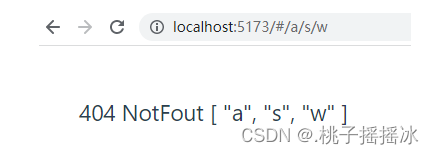
4、首页(登录进去后的页面)
<1>设计页面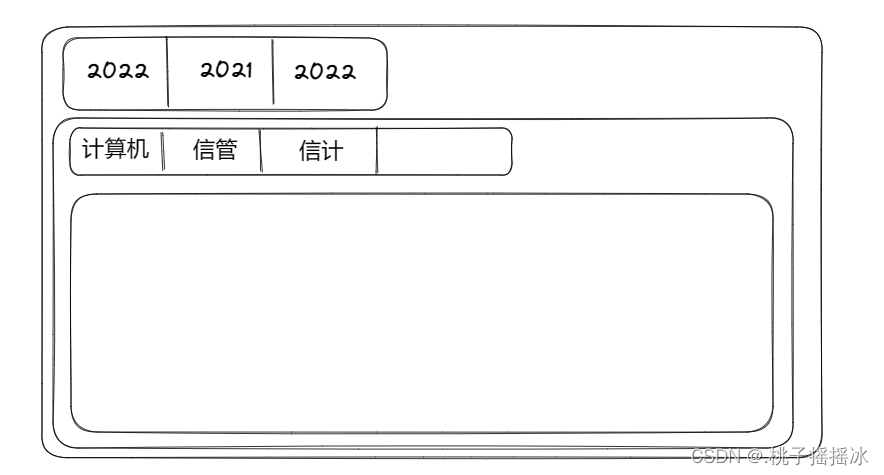
注意:这里就需要路由相关知识了
<2>创建路由
①一级标签可以做成超链接(a链接),但是点击a标签会进行整个页面的刷新,性能低。我们需要点击时,只刷新渲染局部。(改变地址栏路径,页面不会重新刷新)
通过
<router-link to=''></router-link>
来实现
②我们修改LoginFirst.vue组件(只导了template部分的代码)
<template><div class="box1"><ul><router-link to="/grade2022"><li>2022级</li></router-link><router-link to="/grade2021"><li>2021级</li></router-link><router-link to="/grade2020"><li>2020级</li></router-link></ul>// 显示区<router-view></router-view></div></template>
提示:当点击2022时,会在地址栏中显示/grade2022地址,同时,/grade2022会对应一个组件,因此,需要在路由中设置路径与组件的映射
③在路由(Router)中设置映射
创建三个Grade组件
在路由中引入,在完成路径和组件的映射
发现问题?组件太多了,三个组件的模板基本相同,只是数据不同。因此可以写一个组件,复用组件进行传参。
代码优化:
<1>创建一个Grade组件,显示参数
<2>在路由中引入Grade
<3>配置映射,并传参
<4>修改router-link to 中的路径
二、完善需求
1、发现问题:
当路径地址为/grade/2022时,Grade组件显示在App.vue中的区域中,但是我们的需求是想要Grade组件中的内容显示在LoginFirst组件列表的下方。
解决方法:路由的嵌套
<1>修改路由(我这里嵌套了三个路由—Login)
{path:'/logins',name:'logins',component: LoginFirst,children:[{path:'grade/:id',component: Grade,children:[{path:'a1',component: GradeBottom
}]}]},
注意:
1>使用children关键字,值为数组,数组中每一个元素都是路径与组件的映射
2>子路由中路径开始的地方不应该有/
<2>修改路径
![[外链图片转存失败,源站可能有防盗链机制,建议将图片保存下来直接上传(img-Z0tfLB4Y-1677066821435)(C:\Users\Administrator\AppData\Roaming\Typora\typora-user-images\image-20230221211714963.png)]](https://img-blog.csdnimg.cn/ba3581996d264a9996a626a23f858286.png)
访问结果:
![[外链图片转存失败,源站可能有防盗链机制,建议将图片保存下来直接上传(img-VLHCXrMZ-1677066821436)(C:\Users\Administrator\AppData\Roaming\Typora\typora-user-images\image-20230222192337360.png)]](https://img-blog.csdnimg.cn/8aa2b5f838114b2fa28ad9d3b75387b9.png)
<3>修饰样式
LoginFirst.vue
<script>
</script>
<template>
<div class="box1">
<ul>
<!-- class="router-link-active" 设置点击产生高亮行为 -->
<router-link :to="{name:'grade',params:{id:1}}"><li>2022级</li></router-link>
<router-link :to="{name:'grade',params:{id:2}}"><li>2021级</li></router-link>
<router-link :to="{name:'grade',params:{id:3}}"><li>2020级</li></router-link>
</ul>
<div><router-view></router-view></div>
</div>
</template>
<style scoped>
*{
margin: 0;
padding: 0;
}
div.box1 ul li {
display: inline-block;
text-align: center;
margin-left: 15px;
width: 50px;
height: 30px;
line-height: 30px;
background-color: rgb(228, 233, 233);
list-style: none;
}
/* .router-link-active{
background-color:red;
} */
</style>
Grade.vue
<script>
// 导入数据
import data from '../../Data'
export default {
// 定义一个数组接收数据
data() {
return {
list: []
}
},
// 使用参数
props:['id'],
// 钩子函数
mounted() {
// 获取id
const id = this.$route.params.id
// 使用list接收数据,初始化
this.list = data.filter(item => item.id === id)[0].items
},
updated() {
const id = this.$route.params.id;
// 更新时也要更新list
this.list = data.filter(item => item.id === id)[0].items
}
}
</script>
<template>
<!-- <div class="topBox"> Grade---{{ this.$route.params.id }} </div> -->
<div class="divBox">
<router-link v-for='item of list' :to="{
name: 'school',
params: { id }
}">{{ item }}</router-link>
<router-view></router-view>
</div>
</template>
<style scoped>
/* div.topBox {
text-align: center;
} */
a {
margin-left: 10px;
color:rgb(81, 87, 82);
font-size:14px
}
</style>
<4>显示二级标签(就是路由的嵌套)
{path:'/logins',name:'logins',// 当地址为/main时也是登录页面// 使用别名alias:'/main',// 使用重定向// redirect:{name:'logins'},component: LoginFirst,children:[{path:'grade/:id',name:'grade',// 方便传参数props:true,component: Grade,children:[{path:'a1',name:'school',component: GradeBottom
}]}]},
效果图:
![[外链图片转存失败,源站可能有防盗链机制,建议将图片保存下来直接上传(img-K6oD7fKS-1677066821436)(C:\Users\Administrator\AppData\Roaming\Typora\typora-user-images\image-20230222193105881.png)]](https://img-blog.csdnimg.cn/0f4c9ba7c6cd4e9e927ef259d12bcab6.png)
<5>为了让路由的使用更加方便,我们可以给路由设置名称(ps:前面的路由代码中已设置是使用了)
<6>我们设置了名称后,就可以在router-link中使用了,传递参数方便
<router-link :to="{name:'grade',params:{id:1}}"><li>2022级</li></router-link>
<router-link :to="{name:'grade',params:{id:2}}"><li>2021级</li></router-link>
<router-link :to="{name:'grade',params:{id:3}}"><li>2020级</li></router-link>
<7>在push(replace)中使用
this.$router.replace({name:'logins'})
tip:在编程式导航中,可以使用replace替换当前位置,它的作用类似于router.push,唯一的不同是,它在导航时不会向history添加新记录
2、新的需求:
当点击一级菜单时,显示对应的二级菜单,二级菜单各不相同。
<1>如何在组件中获取参数?
通过this.$route.param来获取参数
<2>在Grade组件中获取参数,根据一级菜单不同,加载对应的二级菜单,因此,需要使用生命周期函数mounted页面加载完成后的事情(初始化的工作一般都在此函数中运行)
// 定义一个数组接收数据
data() {
return {
list: []
}
},
// 使用参数
props:['id'],
// 钩子函数
mounted() {
// 获取id
const id = this.$route.params.id
// 使用list接收数据,初始化
this.list = data.filter(item => item.id === id)[0].items
},
注意:data是声明的假数据,真实的数据需要从后台获取
data.js假数据:
// 数据const data =[{id:'1',items:['计算机科学与技术','信息管理','信息与计算']},{id:'2',items:['人工智能','计算机科学','大数据']},{id:'3',items:['云存储','算法','信息与计算']}];exportdefault data
<3>参数更新后也要对数据进行更新,使用updated函数
updated() {
const id = this.$route.params.id;
// 更新时也要更新list
this.list = data.filter(item => item.id === id)[0].items
}
<4>动态渲染
<template>
<!-- <div class="topBox"> Grade---{{ this.$route.params.id }} </div> -->
<div class="divBox">
<router-link v-for='item of list' :to="{
name: 'school',
params: { id }
}">{{ item }}</router-link>
<router-view></router-view>
</div>
</template>
<5>为了方便使用参数,可以将props(路径中的参数)传递给组件。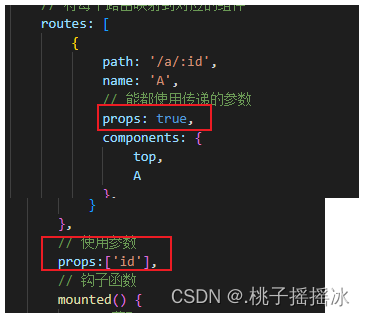
版权归原作者 .桃子摇摇冰 所有, 如有侵权,请联系我们删除。
